Event Stream Processing Market Size
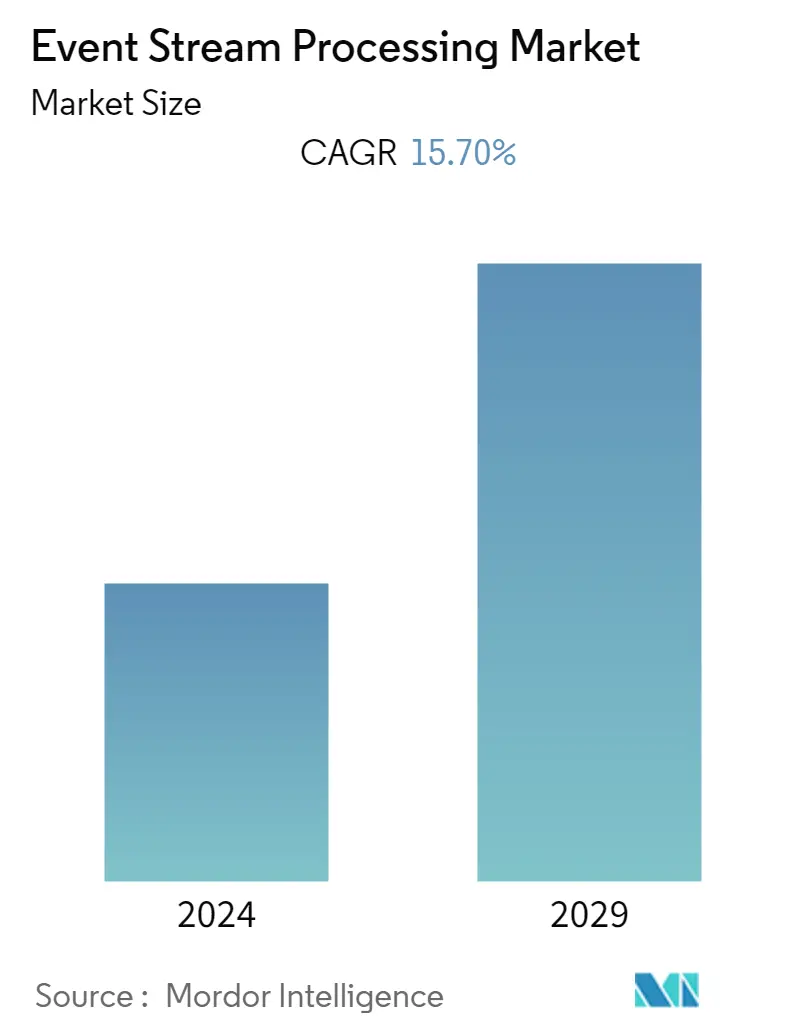
| Study Period | 2019 - 2029 |
| Base Year For Estimation | 2023 |
| CAGR | 15.70 % |
| Fastest Growing Market | Asia-Pacific |
| Largest Market | North America |
| Market Concentration | Medium |
Major Players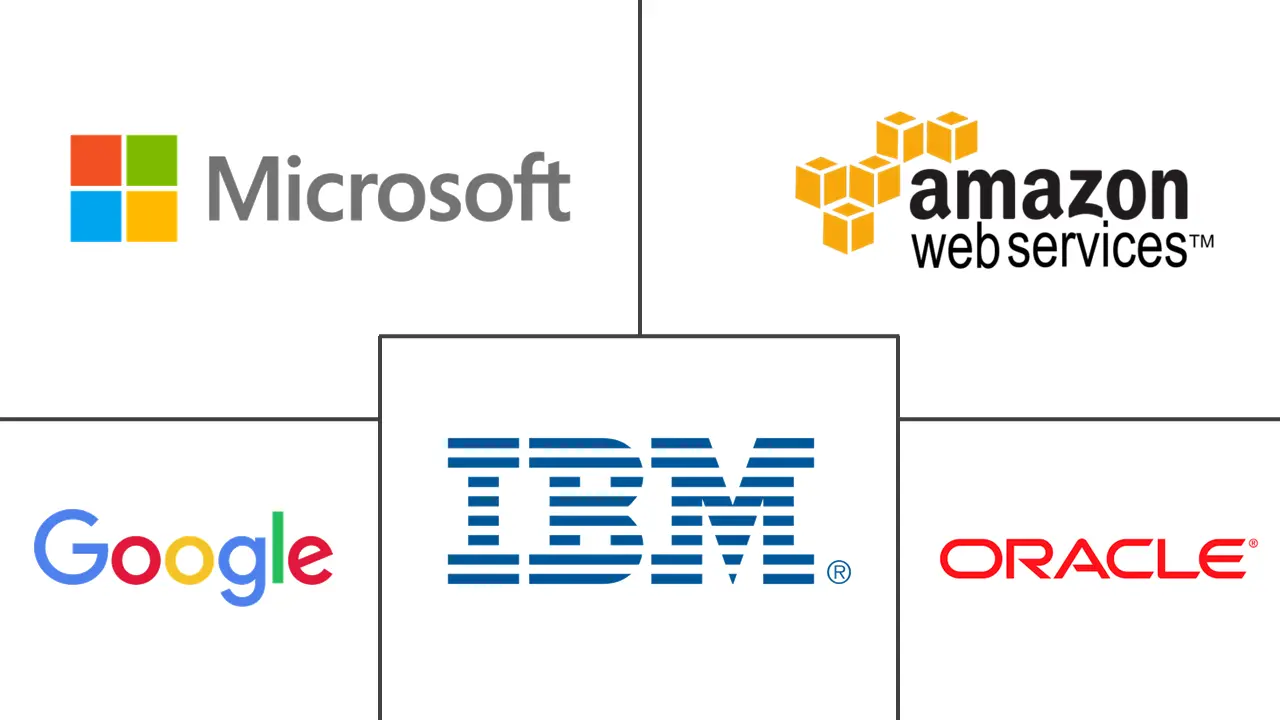
*Disclaimer: Major Players sorted in no particular order |
Event Stream Processing Market Analysis
The Event Stream Processing (ESP) market is expected to witness a CAGR of 15.7% over the forecast period. This market's expansion can be attributed to rising demand for real-time analytics and increased awareness of big data's benefits across sectors. During the forecast period, the growth of the market is also expected to be helped by the growing use of cloud-based event stream processing solutions.
- According to MachEye, people produce 2.5 quintillion bytes of data daily, which is expected to grow faster each year. Business intelligence users are already struggling to translate this explosion of complex data into actionable insights. As a result, there would be a significant demand for more advanced, easy-to-use data translation tools.
- Targeted offers and predictive analytics enable merchants to develop highly personalized offers for all their customers at a very granular level. For instance, retailers can personalize the in-store experience by providing offers to incentivize frequent buying and drive more purchases, thereby achieving higher sales across all their channels. Predictive analytics can be used to upsell or cross-sell a customer. Further, predictive analytics helps businesses predict a customer's lifetime value (CLV). CLV helps forecast a customer's discounted value over time by analyzing past behavior to determine the most profitable customers over time.
- Further, due to the necessity for real-time processing of vast volumes of RFID data, the use of event stream processing in radio-frequency identification (RFID) event processing applications is quickly rising. RFID tags are connected to items or people and generate a signal that an RFID reader can read. This lets businesses keep track of where goods and people are in real time, which is important for many things like managing the supply chain and keeping people safe.
- According to a survey from Sisense, 50% of companies are utilizing predictive analytics more or much more than before the COVID-19 pandemic, including over 68% of small businesses. For instance, a significant challenge of the COVID-19 pandemic was ensuring that clients felt safe when visiting brick-and-mortar stores. With the help of business intelligence tools, social networking platforms, and customer relationship management (CRM) systems, companies could get direct feedback from customers and take the right steps to ensure everyone's health and safety.
- There is a significant increase in the requirement for data analytics and data visualization tools. For example, according to the IBM Quant Crunch, up to 2.72 million jobs require data science skills, making it one of the most in-demand roles across industries. College graduates from the MIS and CS departments know little about database modeling or real-world database environments. There are specific IT sciences majors with database classes, let alone business intelligence and analytics courses. There is a lack of exposure to tools and technologies found in the workplace.
Event Stream Processing Market Trends
This section covers the major market trends shaping the Event Stream Processing Market according to our research experts:
Increasing Adoption of the Internet of Things (IoT) and Smart Devices
- According to a recent Oracle survey, enterprise IoT adopters are prepared to take an easier route. Nearly two-thirds (64%) of the 800 IoT decision-makers surveyed said they would choose an "off-the-shelf" IoT solution over a custom-built one, showing a shift in how businesses purchase IoT products. Additionally, 75% of respondents want the connection baked into or packaged by the solution provider, and 70% want providers to provide data and analytics capabilities as part of a complete solution. The results show that there is a growing need for a simple way to add IoT capabilities that speeds up the time it takes to get value from them.
- Moreover, by this year, there will be close to 30 billion network-connected devices and connections, up from 18.4 billion in 2018, predicts Cisco's Annual Internet Report. By the end of the current year, IoT devices will make up 50% (14.7 billion) of all networked devices, up from 33% (6.1 billion) in 2018.
- According to the Microsoft IoT Signals report, the United States leads the pack with 27% of projects in the usage phase, followed by Spain (22%), and Australia (18%). In terms of accelerating IoT adoption, the US is far ahead of the rest of the world: 78% of US firms intend to increase their IoT usage over the next two years. However, only 53% of By this year, 51% of German businesses and 51% of Japanese businesses planned to increase utilization. This can be due to the more conservative technological adoption in the German and Japanese markets.
- According to Gallup's annual Health and Healthcare survey, 90% of American consumers said they are currently using a wearable fitness tracker, and the same percentage stated that they currently use a mobile health application. By combining the present use with the percentages of Americans that claim, in the past, they have used such devices, it becomes clear that, at some point, one in three Americans used a fitness tracker such as a wristband or smartwatch (34%), or tracked their health statistics on a phone or tablet application (32%).
- Digital assistance combined with AI allows users to deploy smart devices hands-free and more efficiently, dramatically influencing buyer preferences. With the rise of digital assistants such as Alexa, Google Assistant, Siri, and Bixby, smart devices can now be controlled and managed via voice commands. The developing features of these digital assistants, such as Bluetooth speaker control and hands-free channel surfing, are driving the market for smart home gadgets. Buyers also choose customized devices for their ease and improved user experience.
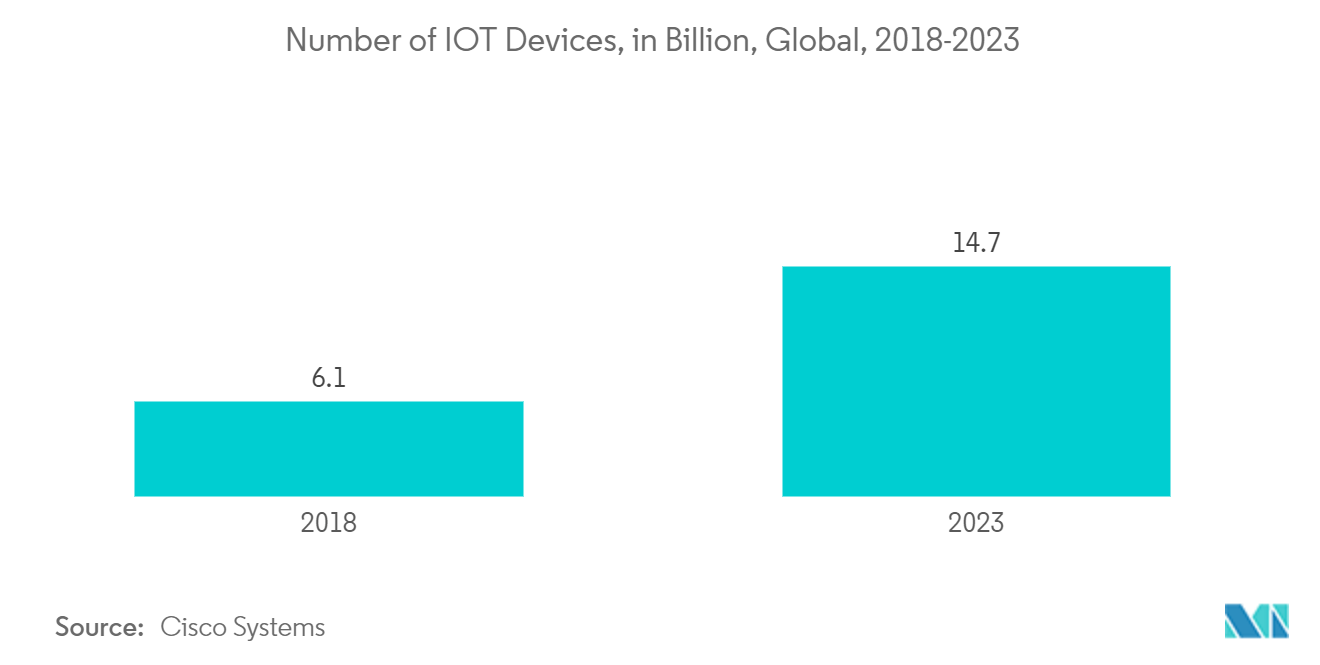
North America is Expected to Hold a Large Share of the Market
- North America is expected to hold the largest market size and dominate the ESP market during the forecast period. The fact that there are a lot of ESP vendors in the area is due to their early adoption of new technologies and high adoption rates, as well as their investments in research and development to improve their event-based offerings.
- The rise in demand for event stream processing is pushing firms in the region to provide new solutions to capture market share. For example, IBM Event Streams is an IBM Cloud Pak for integration capabilities. It gives enterprises access to corporate data via event streams, allowing them to gain insights from event-based data and detect and take action in real time and at scale. The IBM differentiators mentioned were the ability to control event endpoints alongside API administration.
- In February last year, Express Analytics, a US-based data analytics firm, announced that it would enter the Indian market as part of its global expansion strategy, offering artificial intelligence (AI) and machine learning (ML)-based predictive analytics services to companies in the technology, telecom, banking, advertising, and retail industries, as well as the public sector. In addition, the company has made a strategic deal with Delhi-based Mavcomm Advisory to expand its portfolio in the fast-changing digital Indian market.
- The cloud segment in the United States is witnessing several partnership activities. For instance, HCL Technologies, a global technology-oriented company, announced the extension of its partnership with Google Cloud to bring HCL's Actian portfolio offering, Actian Avalanche, to Google Cloud. This hybrid cloud data warehouse is proposed to improve an enterprise's operational analytics workload. Avalanche also offers a business intelligence and analytics platform with Google Cloud and helps popular SaaS and enterprise applications deliver a comprehensive solution that is easy to deploy and consume.
- With increasing numbers of customers switching to digital channels and the high cost of a physical branch network, digital-only banking entities are proliferating. While few financial institutions are launching digital-only banks to collect deposits, others use digital platforms to provide lending, investing, and specialty services. In both cases, the focus is on coming up with new ideas, making the customer experience better, and giving the customer more value. This is only possible with customer data and event stream processing.
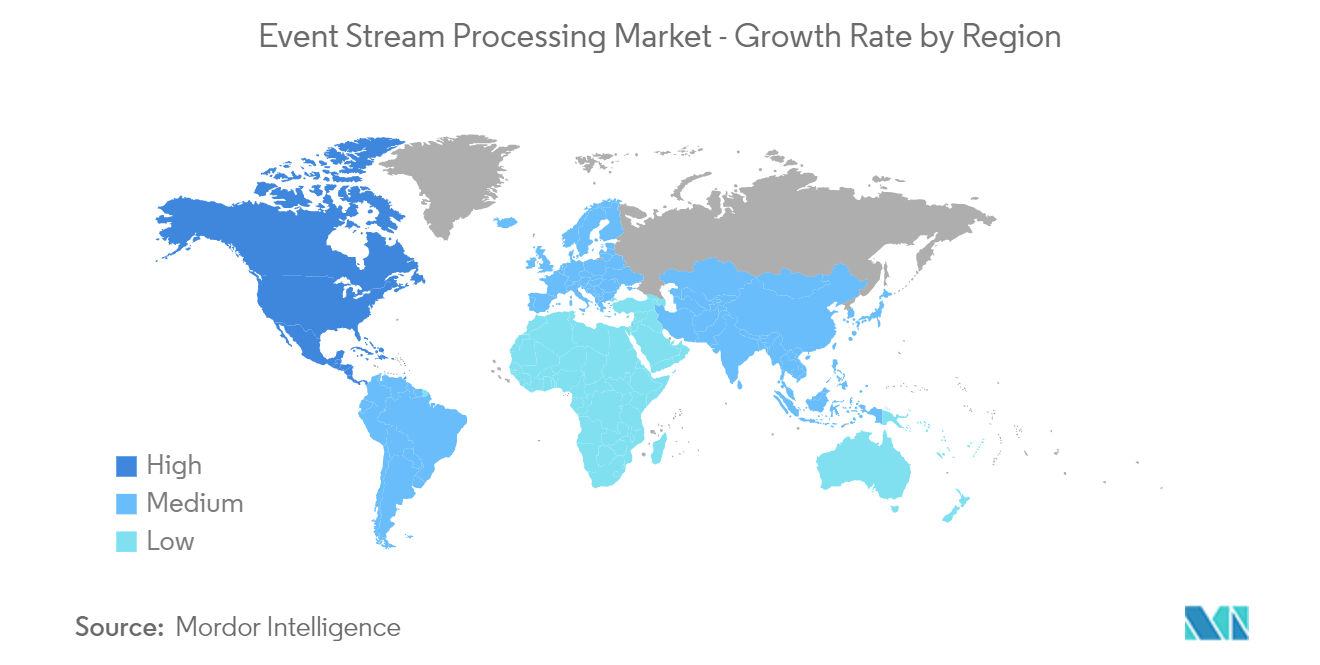
Event Stream Processing Industry Overview
The global event stream processing market is moderately competitive owing to the presence of multiple players. The players in the market are adopting strategies like product innovation, mergers, and acquisitions in order to expand their product portfolios, expand their geographic reach, and primarily to stay competitive in the market.
In October 2022, RisingWave Labs, a business developing a platform for data stream processing, announced a Series A fundraising round of USD 36 million headed by Yunqi Partners, unidentified corporate partners, and angel investors. The money, which brings RisingWave's total investment to more than USD 40 million, will be used to expand the startup's business operations in preparation for the launch of RisingWave Cloud, a new cloud service, in the next few years.
In March 2022, Quine, created by thatDot, will be an open-source streaming graph solution designed for high-volume event processing. Quine, according to thatDot, mixes graph data and streaming technologies to enable the building of real-time, complicated event processing processes at scale. Developing an event-driven microservice for stream processing is a difficult endeavor that combines complex difficulties from the database and distributed systems domains. Consensus, concurrency, transactional logic, clustering behavior, fault tolerance, scalability, balancing read and write performance trade-offs, and other features are all included.
Event Stream Processing Market Leaders
-
IBM Corporation
-
Microsoft Corporation
-
Google Inc.
-
Oracle Corporation
-
Amazon Web Services Inc.
*Disclaimer: Major Players sorted in no particular order
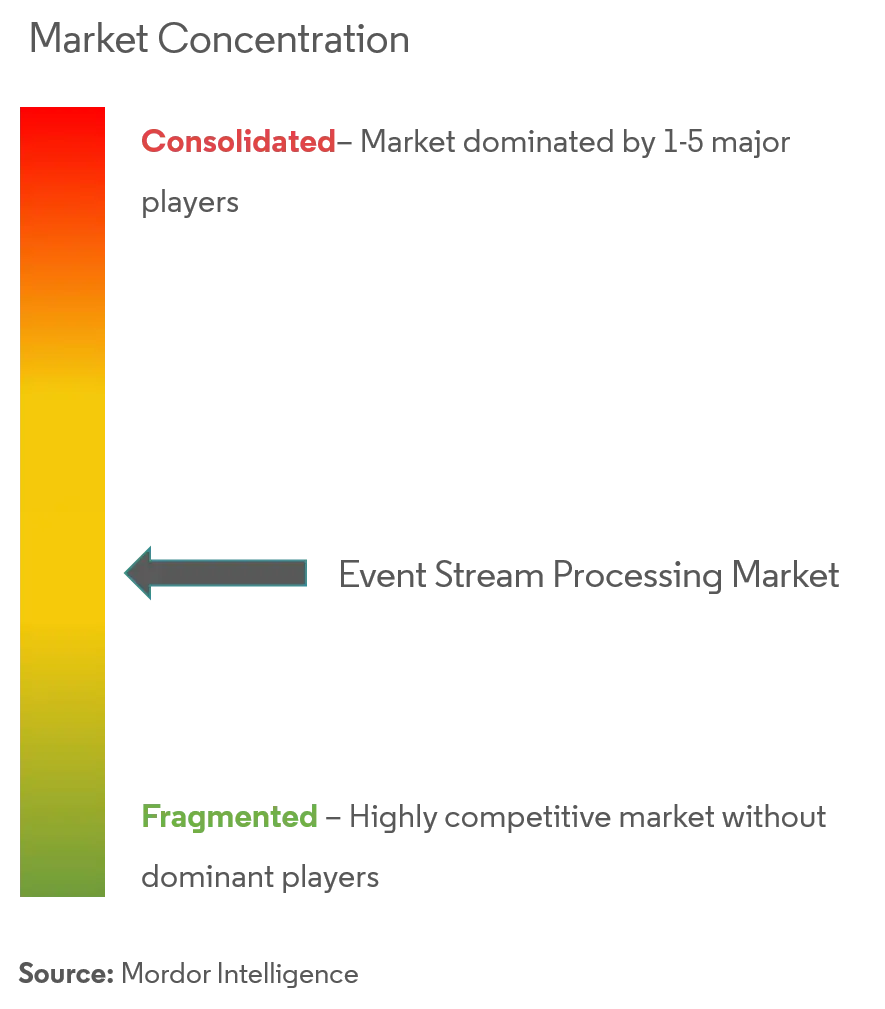
Event Stream Processing Market News
- October 2022: Microsoft has released the Azure Stream Analytics no-code editor, a drag-and-drop canvas for designing jobs for stream processing scenarios such as streaming ETL, ingestion, and data materialization, to general availability. The no-code editor is hosted by Azure Event Hubs, the company's big-data streaming platform and event ingestion service. Azure Stream Analytics is a service for managed real-time analytics. Its no-code editor allows users to develop a Stream Analytics job without writing a single line of code.
- August 2022: DataStax, a real-time data firm, and Decodable, a streaming processing platform company, have announced new cooperation to assist developers in building modern real-time apps and delivering data services in minutes at a significantly lower cost. As a result of the collaboration, the two companies will link their cloud services to take advantage of three powerful open-source technologies: Apache Cassandra, Apache Pulsar, and Apache Flink.
Event Stream Processing Market Report - Table of Contents
1. INTRODUCTION
- 1.1 Study Assumptions and Market Definition
- 1.2 Scope of the Study
2. RESEARCH METHODOLOGY
3. EXECUTIVE SUMMARY
4. MARKET DYNAMICS
- 4.1 Market Overview
-
4.2 Market Drivers
- 4.2.1 Increasing Adoption of the Internet of Things (IoT) and Smart Devices
- 4.2.2 Increasing Need to Analyze Large Volumes of Data From Diverse Sources
-
4.3 Market Restraints
- 4.3.1 Concerns Associated with Data Security and Privacy
-
4.4 Porter's Five Forces Analysis
- 4.4.1 Bargaining Power of Suppliers
- 4.4.2 Bargaining Power of Buyers
- 4.4.3 Threat of New Entrants
- 4.4.4 Threat of Substitute Products
- 4.4.5 Intensity of Competitive Rivalry
5. MARKET SEGMENTATION
-
5.1 Deployment Type
- 5.1.1 Cloud
- 5.1.2 On-premise
-
5.2 Component
- 5.2.1 Solutions (Software & Platforms)
- 5.2.2 Services
-
5.3 Application**
- 5.3.1 Fraud Detection
- 5.3.2 Algorithmic Trading
- 5.3.3 Process Monitoring
- 5.3.4 Predictive Maintenance
- 5.3.5 Sales and Marketing
-
5.4 End-user Vertical
- 5.4.1 IT & Telecommunications
- 5.4.2 BFSI
- 5.4.3 Manufacturing
- 5.4.4 Retail & E-commerce
- 5.4.5 Energy & Utilities
- 5.4.6 Other End-user Verticals
-
5.5 Geography
- 5.5.1 North America
- 5.5.2 Europe
- 5.5.3 Asia-Pacific
- 5.5.4 Latin America
- 5.5.5 Middle-East and Africa
6. COMPETITIVE LANDSCAPE
-
6.1 Company Profiles*
- 6.1.1 IBM Corporation
- 6.1.2 Microsoft Corporation
- 6.1.3 Google Inc.
- 6.1.4 Oracle Corporation
- 6.1.5 Amazon Web Services Inc.
- 6.1.6 Salesforce
- 6.1.7 Redhat
- 6.1.8 SAP SE
- 6.1.9 TIBCO
- 6.1.10 Hazelcast IMDG
- 6.1.11 SAS
- 6.1.12 Confluent, Inc.
- 6.1.13 Hitachi Vantara
- 6.1.14 Informatica
7. INVESTMENT ANALYSIS
8. MARKET OPPORTUNITIES AND FUTURE TRENDS
** Subject To AvailablityEvent Stream Processing Industry Segmentation
Event stream processing (ESP) is a computer programming approach for detecting, responding to, and transforming information streams (event streams) as they happen. ESP can process data in real-time as it arrives or in near-real time with a little delay.
The Event Stream Processing Market is segmented by Deployment Type (Cloud, On-premise), Component (Solutions, Services), Application (Fraud Detection, Algorithmic Trading, Process Monitoring, Predictive Maintenance, Sales, and Marketing), End-user Vertical (IT & Telecommunications, BFSI, Manufacturing, Retail & E-commerce, Energy & Utilities), and Geography (North America, Europe, Asia Pacific, Latin America, the Middle East, and Africa).
The market sizes and forecasts are provided in terms of value (USD million) for all the above segments.
| Deployment Type | Cloud |
| On-premise | |
| Component | Solutions (Software & Platforms) |
| Services | |
| Application** | Fraud Detection |
| Algorithmic Trading | |
| Process Monitoring | |
| Predictive Maintenance | |
| Sales and Marketing | |
| End-user Vertical | IT & Telecommunications |
| BFSI | |
| Manufacturing | |
| Retail & E-commerce | |
| Energy & Utilities | |
| Other End-user Verticals | |
| Geography | North America |
| Europe | |
| Asia-Pacific | |
| Latin America | |
| Middle-East and Africa |
Event Stream Processing Market Research FAQs
What is the current Event Stream Processing Market size?
The Event Stream Processing Market is projected to register a CAGR of 15.70% during the forecast period (2024-2029)
Who are the key players in Event Stream Processing Market?
IBM Corporation, Microsoft Corporation, Google Inc., Oracle Corporation and Amazon Web Services Inc. are the major companies operating in the Event Stream Processing Market.
Which is the fastest growing region in Event Stream Processing Market?
Asia-Pacific is estimated to grow at the highest CAGR over the forecast period (2024-2029).
Which region has the biggest share in Event Stream Processing Market?
In 2024, the North America accounts for the largest market share in Event Stream Processing Market.
What years does this Event Stream Processing Market cover?
The report covers the Event Stream Processing Market historical market size for years: 2019, 2020, 2021, 2022 and 2023. The report also forecasts the Event Stream Processing Market size for years: 2024, 2025, 2026, 2027, 2028 and 2029.
Event Stream Processing Industry Report
Statistics for the 2023 Event Stream Processing market share, size and revenue growth rate, created by Mordor Intelligence™ Industry Reports. Event Stream Processing analysis includes a market forecast outlook to 2029 and historical overview. Get a sample of this industry analysis as a free report PDF download.



